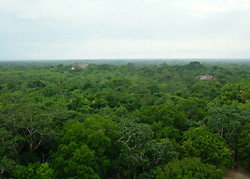
|
|
|
HISTORY
On a limestone plateau in the northern region of the Yucatan peninsula lie the relics of Chichén Itzá, once one of the most powerful cities of the Maya. Ruins of the temples of this ancient civilization spread from the jungles of Guatemala to the Yucatan. Today, Chichén Itzá attracts thousands of visitors who come to marvel at the spectacular remains.  The Mayan Civilization
The Mayan Civilization
The Maya originated around 3,000 years ago in present-day Honduras, Mexico, Guatemala, and Belize. From around AD 250 to AD 900, the Mayan empire flourished in the southern regions. Around AD 900, the empire in the south collapsed. No one knows why. Scholars have suggested, among other reasons, political upheaval, drought, disease, or overpopulation. But while the empire in the south waned, that in the north, especially in the Yucatan, flourished until the Spanish conquests of the sixteenth century.  The Maya were skilled farmers and created a very sophisticated written language; some think it may have been the first written language native to the Americas. The Maya also developed a well-ordered social class system and carried on trade throughout a network of cities that went as far north as Central Mexico and as far south as Panama. Expert mathematicians, their number system included the concept of zero, an idea unknown to the ancient Greeks, expert mathematicians themselves. The Maya used their mathematical knowledge along with celestial observations to finesse a calendar created by the Olmec (a culture from the Mexican Gulf Coast) and to create monuments to observe and commemorate movements of the sun, the moon, and Venus. Spectacular examples of these monuments can still be seen at Chichén Itzá.
The Maya were skilled farmers and created a very sophisticated written language; some think it may have been the first written language native to the Americas. The Maya also developed a well-ordered social class system and carried on trade throughout a network of cities that went as far north as Central Mexico and as far south as Panama. Expert mathematicians, their number system included the concept of zero, an idea unknown to the ancient Greeks, expert mathematicians themselves. The Maya used their mathematical knowledge along with celestial observations to finesse a calendar created by the Olmec (a culture from the Mexican Gulf Coast) and to create monuments to observe and commemorate movements of the sun, the moon, and Venus. Spectacular examples of these monuments can still be seen at Chichén Itzá.
|